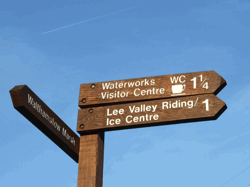 |
|
|
|||
BIRD WATCHING ON WALTHAMSTOW MARSH | |||
|
For the bird watcher the changing seasons always provide a unique feeling, seeing and hearing birds that have travelled great distances on migration, and return periodically year after year to Winter or to Summer. On hearing the first willow warbler and meeting the first swallow in Spring is like meeting an old friend who has returned home.
The Walthamstow Marshes are no exception. And I will never cease to be amazed at watching sedge warblers and reed warblers chattering and grating their song from the tips of reeds with a London pub in the background. When I first went bird watching on Walthamstow Marshes some years ago, I was never expecting the place to have such a wealth and variety of bird life. For example, on the last Sunday of August of this year I was out there early at 7 am. By the time I returned home a few hours later I had spotted and counted 45 different species on and around the Marshes. On the reservoirs there was the greenshank, an oystercatcher, a dunlin (and I was able to creep within 10 yards of it) and overhead flew some four species of gulls. On the field beside the Marshes I came across a flock of Canada geese grazing; and closer examination with binoculars revealed one feral greylag goose among them. The sallows on the Marshes were teeming with life. Every branch held chattering birds. I counted over a hundred and fifty goldfinches! A willow warbler was in full song, an unusual occurence for late August. The blue tits were busily coming into song again. I also saw a spotted flycatcher. And all this time sand martins and swallows were flying and darting over the Marshes and reservoirs. Sadly the redpolls, which built their nest too close to the path, where it runs between the sallows, not only lost their eggs, but their nests as well. I have not seen them return for two years. However, the redpoll's close relative, the linnet, continues to return every Summer, and a few may be seen during the Winter. Spring time will provide several terns passing through, and a good variety of wading species, such as the common sandpiper, the little ringed plover, the lapwing, the greenshank and the dunlin. If one is very lucky, the unexpected bird may appear, perhaps an avocet, a wheatear or another unusual passing migrant. Winter can provide very good birdwatching, with the reservoirs attracting wildfowl in large numbers. However, I shall never forget that unforgettable day in January, when I watched a kingfisher and a robin face to face on a stone wall beside the Marshes, utterly surprised at each other's bright appearance. They glared at each other, but soon departed in opposite directions. Skylarks, redwings, fieldfares, meadow pipits and tree sparrows are but a few of the birds one can see on a cold Winter's morning over the Marshes looking for food. A good 40 species of wild birds can be seen on the Marshes on any average day. The habitat has such variety; the large group of sallows growing on the piles of earth heaped there when the marina was dug out some seven years back; the river which runs along the edge of the Marshes; the great variety of wild flowers from comfrey to meadowsweet to vetch to thistle to dock to wild hops - a long list; the great areas of sedge, which bow so gracefully in the wind; the grasses and the tall reeds. They attract so many different types of bird, for breeding, for feeding or for roosting. How exciting to preserve this facility, so close to the centre of London, and what an ideal opportunity for education, to be found on our doorstep! In the event that the Lee Valley Park Authority were to realise the great naturalist value of the Marshes, and resolve to preserve it, and not to destroy it, steps could be taken to make use of the great educational potentials of the Marshes. Without overburdening the Marshes or cluttering them up, hides could be constructed in select spots for bird watching. Paths to them could be made, which would make the hides available to even crippled and handicapped people, who get profound enjoyment from birdwatching. The Authority, in conjunction with the two neighbouring educational committees could develop this activity for local schoolchildren, although such management of the Marshes must not entail the loss of any part of it as open land for the public. The Marshes are also more than big enough to have shallow pools or scrapes made in them, which would attract additional species of birds, especially waders. Again, there is scope for some planting of trees and shrubs, which would not only increase the variety of birds attracted to the Marshes, but would add to the beauty of its appearance. Every birdwatcher has a rich store of unforgettable experiences. One of mine, with which I conclude this little piece, is of the sedge warblers of Walthamstow Marshes in late September. These birds are only 110mm (4.5in) in size. Normally they are as quick and speedy as shafts of light, flitting among the reeds. But not in late September. In the Summer months they eat and eat to build up a large store of fat. They are then heavy, roughly double their weight. The reeds of the Marshes bent beneath them, before they flew off, as from all parts of the country, on their long, non-stop migration to the Sahara, and then beyond to the marshlands of tropical Africa. | |||

(4/June/2012) Walthamstow Marsh close to the board walk. | |||
 | Click to go to next section |